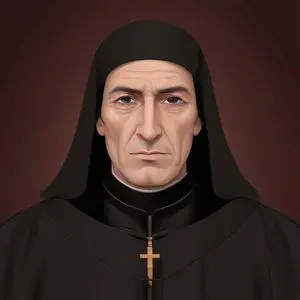Girolamo Savonarola: The Fiery Prophet of Renaissance Florence
A Champion of Reform and Christian Renewal
Girolamo Savonarola was a Dominican friar and preacher who shook the foundations of Renaissance Florence with his prophecies of civic glory, advocacy for the destruction of secular art and culture, and calls for Christian renewal. He is known for his denunciations of clerical corruption, despotic rule, and the exploitation of the poor, earning him both admiration and scorn from the people and the Church.
Early Life and Education
Born on September 21, 1452, in Ferrara, Italy, Savonarola was drawn to a life of asceticism and spirituality from a young age. He joined the Dominican Order in 1475 and went on to study theology and philosophy at the University of Ferrara. His education and spiritual pursuits shaped his strong convictions and zeal for reform.
Rise to Prominence
In 1490, Savonarola arrived in Florence, where he began to preach and gain a following. His sermons were marked by their passion, eloquence, and fierce criticism of the corruption and moral decay of the time. He became a powerful voice for change, calling for the reform of the Church and the city's government.
The French Invasion and the Florentine Republic
In 1494, King
Charles VIII of France invaded Italy, threatening Florence. Savonarola's prophecies seemed on the verge of fulfillment, and he played a key role in mediating between the French king and the Florentines. The ruling Medici family was expelled, and a new republic was established, with Savonarola as its spiritual leader.
Moralistic Campaign and the Bonfires of the Vanities
Savonarola's campaign for reform reached new heights, as he called for the destruction of secular art and culture, deeming it immoral and corrupting. The famous "Bonfires of the Vanities" were held, where people were encouraged to burn their luxurious and sinful belongings. This extreme moralism won him both admiration and criticism.
Conflict with the Vatican
Savonarola's defiance of
Pope Alexander VI's authority led to his excommunication in 1497. He continued to preach, despite the ban, and was eventually arrested and put on trial. In 1498, he was condemned, hanged, and burned at the stake in the main square of Florence.
Legacy and Impact
Savonarola's movement, though short-lived, left a lasting impact on Florence and the Catholic Church. His devotees, the Piagnoni, continued to advocate for republican freedom and religious reform well into the following century. His legacy serves as a testament to the power of conviction and the importance of moral leadership.
Quotes and Memorable Sayings
- "It is not the interest of the Church to have people rich, but to have people holy."
- "The Lord has called me to prophesy the reform of the Church."
- "Oh, Florence, you will be reborn, and you will be more glorious than ever."
Influence on Modern Society
Savonarola's crusade against corruption and moral decay continues to inspire reformers and activists today. His emphasis on the importance of spiritual renewal and moral leadership remains a powerful message for contemporary society.
FAQ
What were Girolamo Savonarolas key teachings and beliefs?
Girolamo Savonarola was a Dominican friar who preached about the need for moral and spiritual reform in Florence. He believed in the importance of individual piety, condemned corruption and luxury, and advocated for a more austere and simple way of life.
How did Girolamo Savonarola rise to power in Florence?
Girolamo Savonarola rose to power in Florence through his powerful preaching and his ability to tap into the citys desire for reform. He became a key advisor to the Medici family and played a crucial role in shaping the citys politics and culture.
What was Girolamo Savonarolas relationship like with the Medici family?
Girolamo Savonarolas relationship with the Medici family was complex and tumultuous. He initially enjoyed their support, but later clashed with them over issues of morality and corruption. He was eventually excommunicated and executed by the Medicis.
What were Girolamo Savonarolas views on art and culture?
Girolamo Savonarola was a fierce critic of the excesses of Renaissance art and culture, viewing them as pagan and corrupting. He advocated for a more austere and simple style, and his followers destroyed many works of art in the Bonfire of the Vanities.
How did Girolamo Savonarolas legacy impact the development of Protestantism?
Girolamo Savonarolas legacy had a significant impact on the development of Protestantism, influencing the thought and ideas of reformers such as Martin Luther and John Calvin. His emphasis on individual piety and moral reform helped shape the Protestant movement.

